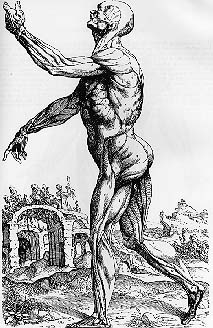
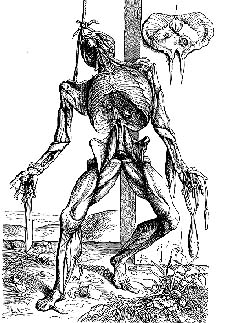
The following two images (plates 25 and 30, respectively of Vesalius' book) illustrate two important aspects of his work:

| Plate 25 is a drawing of the muscle system of the body. Each major muscle is lettered and discussed in the text (the numbers are not visible on-screen). Note the artistic aspect of this drawing: the male figure (usual for Vesalius, but note the exception below) is moving, with its hands gesticulating to the sky above and the earth below. In the background is the image of a classical ruin. |

| Plate 30 is more gruesome but equally educational: it shows a figure with the muscles partly peeled away, to show the abdominal and thoracic cavities. The artistic effect is a bit bizarre -- the figure is hanging with a noose around its next -- but this may just be an added touch of realism -- to supply a means of supporting the corpse in an upright (or almost upright) position. |
In both cases, anatomical precision is combined with artistic representation. The influence of the rediscovery of perspective in the Renaissance played an important role here. Now, consider Plate 80:
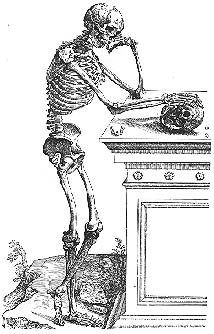
| Here we have a cadaver, stripped to its bones, inspecting a skull. Note the skeleton supports its own skull with its left hand -- in a reflective, thoughtful gesture --, as its right hand rests on the second skull -- which appears as the object of its study. In a sense, we have nature (represented by the full skeleton) examining itself (represented by the second skull)! |
But let's look at a cultural (or ideological) element of this appeal to the study of nature -- with respect to gender. Which gender represents nature as the agent of study (the full skeleton)? Which gender represents nature as the object of study (the detached skull)? The following two images (Plates 80 and 81) provide a clue to this problem:
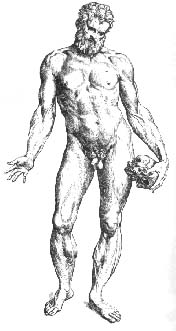
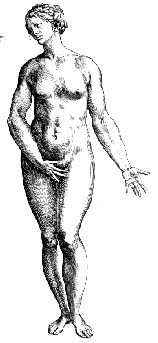
On the left (Plate 80) we have a male nude, who like the skeleton in Plate 79, possesses the object of study (a skull held in his left hand). The individual is depicted in a rather classic Greek pose, with knees bent and one foot further forward than the other. He is not modest in his nudity. Compare this to the female (Plate 81) on the right. She lacks the skull (and so, is not the agent of study), and moreover covers her sexual organs in a moment of modesty.
We can detect two aspects of Vesalius' work in the images we have just glanced at:
Now, you can go back to the third week study plan, or go on to the next topic in the study plan: Harvey's New Physiology